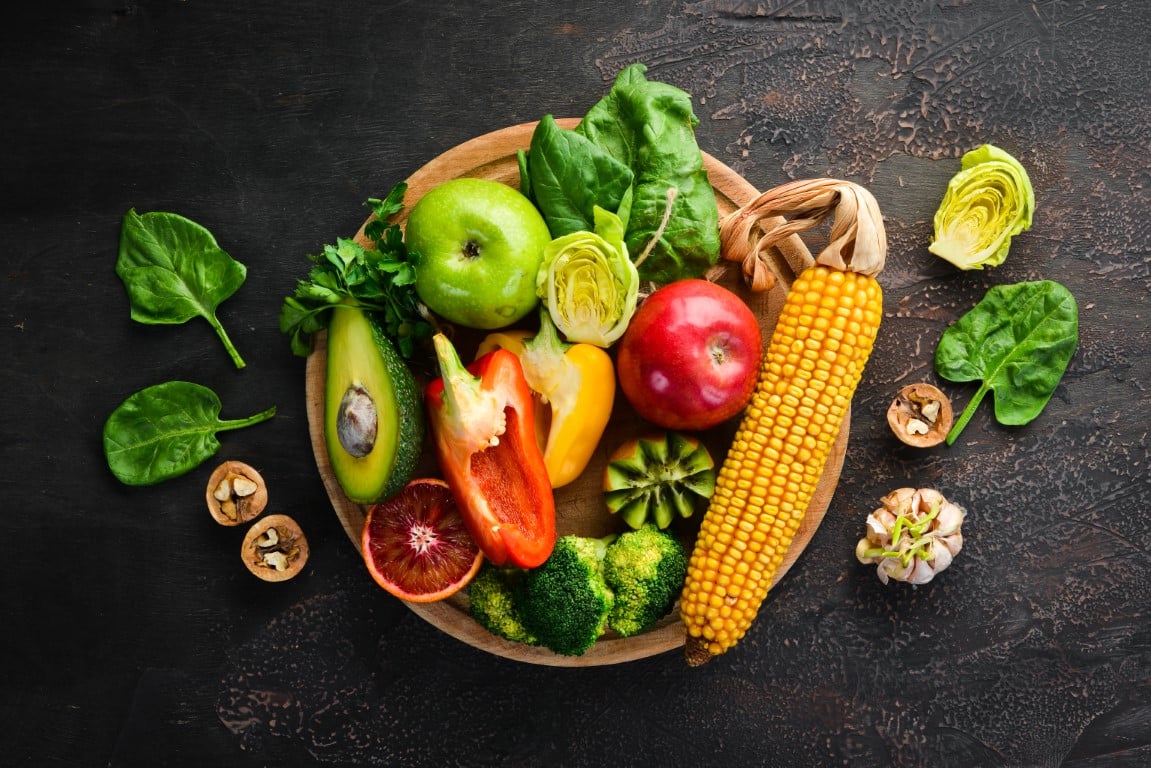Fiber is incredibly important.
It leaves your stomach undigested and ends up in your colon, where it feeds friendly gut bacteria, leading to various health benefits (1, 2).
Certain types of fiber may also promote weight loss, lower blood sugar levels and fight constipation (3, 4, 5).
The recommended daily intake is 25 grams for women and 38 grams for men (6).
However, most people are only eating around half of that, or 15–17 grams of fiber per day (7).
Fortunately, increasing your fiber intake is relatively easy — simply integrate foods into your diet that have a high percentage (%) of fiber per weight.
Here are 22 high-fiber foods that are both healthy and satisfying.

1. Pears (3.1%)
The pear is a popular type of fruit that is both tasty and nutritious. It’s one of the best fruit sources of fiber.
Fiber content: 5.5 grams in a medium-sized pear, or 3.1 grams per 100 grams (8).
2. Strawberries (2%)
Strawberries are incredibly delicious. Plus, they’re a much healthier option than any junk food.
Interestingly, they’re also among the most nutrient-dense fruits you can eat — loaded with vitamin C, manganese and various powerful antioxidants.
Fiber content: 3 grams in one cup, or 2 grams per 100 grams. This is very high given their low calorie content (9).
3. Avocado (6.7%)
The avocado is different from most fruits. Instead of being high in carbs, it’s loaded with healthy fats.
Avocados are very high in vitamin C, potassium, magnesium, vitamin E and various B vitamins. They also have numerous health benefits.
Fiber content: 10 grams in a cup, or 6.7 grams per 100 grams (10).
4. Apples (2.4%)
Apples are among the tastiest and most satisfying fruits you can eat. They are also relatively high in fiber.
Fiber content: 4.4 grams in a medium-sized apple, or 2.4 grams per 100 grams (11).
5. Raspberries (6.5%)
Raspberries are highly nutritious with a very strong flavor. They’re loaded with vitamin C and manganese.
Fiber content: One cup contains 8 grams of fiber, or 6.5 grams per 100 grams (12).
6. Bananas (2.6%)
Bananas are a good source of many nutrients, including vitamin C, vitamin B6 and potassium.
A green or unripe banana also contains a significant amount of resistant starch, a type of indigestible carbohydrate that functions like fiber.
Fiber content: 3.1 grams in a medium-sized banana, or 2.6 grams per 100 grams (13).
Other High-Fiber Fruits
Blueberries (2.4%) and blackberries (5.3%).
7. Carrots (2.8%)
The carrot is a root vegetable that is tasty, crunchy and highly nutritious.
It’s high in vitamin K, vitamin B6, magnesium and beta-carotene, an antioxidant that gets turned into vitamin A in your body.
Fiber content: 3.6 grams in one cup, or 2.8 grams per 100 grams. This is very high given their low calorie content (14).
8. Beets (2.8%)
The beet, or beetroot, is a root vegetable that is high in various important nutrients, such as folate, iron, copper, manganese and potassium.
Beets are also loaded with inorganic nitrates, which are nutrients shown to have various benefits related to blood pressure regulation and exercise performance (15).
Fiber content: 3.8 grams per cup, or 2.8 grams per 100 grams (16).
9. Broccoli (2.6%)
Broccoli is a type of cruciferous vegetable and one of the most nutrient-dense foods on the planet.
It is loaded with vitamin C, vitamin K, folate, B vitamins, potassium, iron and manganese and contains antioxidants and potent cancer-fighting nutrients.
Broccoli is also relatively high in protein, compared to most vegetables.
Fiber content: 2.4 grams per cup, or 2.6 grams per 100 grams (17).
10. Artichoke (8.6%)
The artichoke doesn’t make headlines very often. However, this vegetable is high in many nutrients and one of the world’s best sources of fiber.
Fiber content: 10.3 grams in one artichoke, or 8.6 grams per 100 grams (18).
11. Brussels Sprouts (2.6%)
The Brussels sprout is a type of cruciferous vegetable that is related to broccoli.
They’re very high in vitamin K, potassium, folate and potent cancer-fighting antioxidants.
Fiber content: 4 grams per cup, or 2.6 grams per 100 grams (19).
Other High-Fiber Vegetables
Almost all vegetables contain significant amounts of fiber. Other notable examples include kale (3.6%), spinach (2.2%) and tomatoes (1.2%).
12. Lentils (7.9%)
Lentils are very cheap and among the most nutritious foods on earth. They’re very high in protein and loaded with many important nutrients.
Fiber content: 15.6 grams per cup of cooked lentils, or 7.9 per 100 grams (20).
13. Kidney Beans (6.4%)
Kidney beans are a popular type of legume. Like other legumes, they’re loaded with plant-based protein and various different nutrients.
Fiber content: 11.3 grams per cup of cooked beans, or 6.4 per 100 grams (21).
14. Split Peas (8.3%)
Split peas are made from the dried, split and peeled seeds of peas.
Fiber content: 16.3 grams per cup of cooked split peas, or 8.3 per 100 grams (22).
15. Chickpeas (7.6%)
The chickpea is another type of legume that’s loaded with nutrients, including minerals and protein.
Fiber content: 12.5 grams per cup of cooked chickpeas, or 7.6 per 100 grams (23).
Other High-Fiber Legumes
Most legumes are high in protein, fiber and various nutrients. When properly prepared, they’re among the world’s cheapest sources of quality nutrition.
Other high-fiber legumes include black beans (8.7%), edamame (5.2%), lima beans (5.3%) and baked beans (5.5%).
16. Quinoa (2.8%)
Quinoa is a pseudo-cereal that has become incredibly popular among health-conscious people in the last few years.
It’s loaded with many nutrients, including protein, magnesium, iron, zinc, potassium and antioxidants, to name a few.
Fiber content: 5.2 grams per cup of cooked quinoa, or 2.8 per 100 grams (24).
17. Oats (10.6%)
Oats are among the healthiest grain foods on the planet. They’re very high in vitamins, minerals and antioxidants.
They contain a powerful soluble fiber called oat beta-glucan, which has major beneficial effects on blood sugar and cholesterol levels (25, 26).
Fiber content: 16.5 grams per cup of raw oats, or 10.6 grams per 100 grams (27).
18. Popcorn (14.5%)
If your goal is to increase your fiber intake, popcorn may be the best snack you can eat.
Air-popped popcorn is very high in fiber, calorie for calorie. However, if you add a lot of fat, then the fiber-calorie ratio will be reduced significantly.
Fiber content: 1.2 grams per cup of air-popped popcorn, or 14.5 grams per 100 grams (28).
Other High-Fiber Grains
Nearly all whole grains are high in fiber.
19. Almonds (12.5%)
Almonds are a popular type of tree nut.
They’re very high in many nutrients, including healthy fats, vitamin E, manganese and magnesium.
Fiber content: 3.4 grams per ounce, or 12.5 grams per 100 grams (29).
20. Chia Seeds (34.4%)
Chia seeds are tiny black seeds that are immensely popular in the natural health community.
They’re highly nutritious, containing high amounts of magnesium, phosphorus and calcium.
Chia seeds may also be the single best source of fiber on the planet.
Fiber content: 10.6 grams per ounce of dried chia seeds, or 34.4 grams per 100 grams (30).
Other High-Fiber Nuts and Seeds
Most nuts and seeds contain significant amounts of fiber. Examples include coconuts (9%), pistachios (10%), walnuts (7%), sunflower seeds (8.6%) and pumpkin seeds (18.4%).
21. Sweet Potatoes (2.5%)
The sweet potato is a popular tuber that is very filling and has a delicious sweet flavor. It’s very high in beta-carotene, B vitamins and various minerals.
Fiber content: A medium-sized boiled sweet potato (without skin) has 3.8 grams of fiber, or 2.5 grams per 100 grams (31).
22. Dark Chocolate (10.9%)
Dark chocolate is arguably one of the world’s most delicious foods.
It’s also surprisingly high in nutrients and one of the most antioxidant-rich and nutrient-dense foods on the planet.
Just make sure to choose dark chocolate that has a cocoa content of 70–95% or higher and avoid products loaded with added sugar.
Fiber content: 3.1 grams in a 1-ounce piece, or 10.9 grams per 100 grams (32).
The Bottom Line
Fiber is an important nutrient that may promote weight loss, lower blood sugar levels and fight constipation.
Most people don’t meet the recommended daily intake of 25 grams for women and 38 grams for men.
Try adding some of the foods from the above list to your diet to easily increase your fiber intake.










